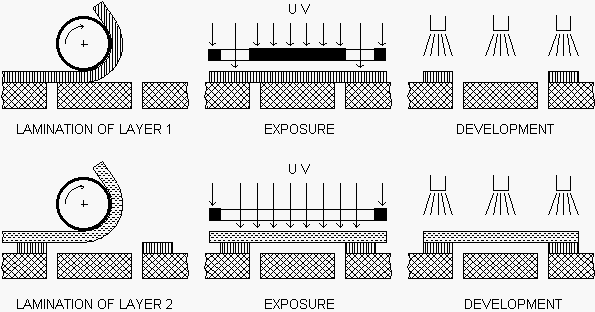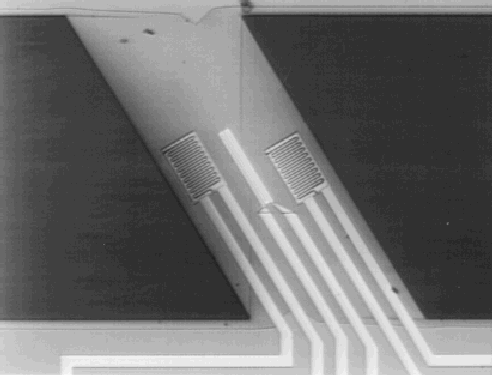
Miniaturized Sensor Systems
F. Kohl, P. Svasek, A. Jachimowicz, G. Jobst, F. Keplinger, G. Urban
Institut für allgemeine Elektrotechnik und Elektronik, TU Wien
L. Boltzmann Institut für biomedizinische Mikrotechnik
A-1040 Vienna, Austria
The acceptance of sensor concepts by industrial equipment producers requires an optimization of the sensor design for the specific application. We developed miniaturized thermal flow sensor designs for very different applications like a novel gas meter, for the investigation of the air intake of combustion engines and an extremely sensitive version for monitoring the flow of excess liquor cerebrospinalis during hydrocephalus treatment. In the field of biosensors, good sensor specifications are not sufficient for broad acceptance by the analytical equipment industry. The needs of a complete analytical process have to be considered by the sensor developer. For such purposes we established a cheap technology for the production of miniaturized fluid handling modules based on dry photoresists [1]. The flexibility of this technology allows the realization of complex structures needed for analyte preprocessing.
Because of their inherent advantages as low analyte consumption, quick response, and cheapness, miniaturized sensors are very attractive for biomedical and many other applications. Sensors intended for example for the survey of industrial processes or for the monitoring of biomedical systems must fit perfectly into the specific system for doing their job as good as possible. These biosensor systems have to fulfill many different tasks as establishing the right environment for the sensor functioning, handling of the analytes, linking the sensor signal to the information processing equipment. Only a complete miniaturized sensor system will be acceptable for applications outside the research labs.
Beside such system aspects, the sensor element itself must match to the specific requirements of the intended use as good as possible. As a consequence, in some cases completely different manufacturing procedures have to be used even for sensors based on the very same technological concept. The presented examples of miniaturized thermal flow sensors are good examples to demonstrate this influence.
Dry film resist technology for miniaturized analyte handling modules
Dry films resists are available as etching resists and for solder masks (i.e. VACRELÒ ). The patterning of each resist layer is a three-step process: lamination, exposure, developing (Fig. 1). The achievable aspect ratio is approx. 0.5, e.g. grooves with a width of 100 µm can be formed if the layer thickness does not exceed 50 µm. The walls are not perpendicular to the surface but undercut at an angle of 15° . If structures higher than 100 µm are desired, the process can be repeated using the same mask. We showed that three-dimensional structures can be realized without special bonding techniques. The complete process is illustrated in Fig. 1.

Fig. 1: Dry resist based manufacturing of a flow channel
The resist material must be cured after patterning of the last layer. This process consists of a temperature step and a final exposure to UV light.
Many biosensors require perfect mixing of the analyte and some added agents to produce accurate results. Miniaturized flow channels obstruct the mixing of fluids because of their inherent laminar flow profiles. We designed a miniaturized Moebius-type mixer [2] which on the one hand enhances the useful flow range and on the other hand reduces the required dead volume.
Miniaturized flow sensors
Micro Flow Sensor Treatment of Hydrocephalus
This sensor (Fig. 2) is a part of a miniaturized all-silicon device for the aid of patients suffering from hydrocephalus [3]. This device should measure the intracranial pressure and automatically opens a shunt for excessive liquor cerebrospinalis if required. The flow sensor serves for continuous monitoring and should detect reverse flow too. The flow sensor was placed on a thin film membrane borne by a micro-machined Si structure for highest flow sensitivity. A special mask alignment equipment that is capable for mask adjustment related to structures at the backside of the wafer is needed for the sensor manufacturing. This equipment is now available at MISZ laboratories. The desired flow detection limit for this application, namely 50µL/h was experimentally verified. It is planned to implement similar sensors in controlled drug delivery devices.
A sensor for the study of the air Intake of combustion engines
The air intake rate of a combustion engine is one of the key parameters needed for optimizing the combustion process. To investigate the dynamic behavior of a suction system, a useful flow sensor must offer quick response, high sensitivity, recognition of flow direction, and a wide dynamic range. Miniaturized thermal anemometers, based on thin film Ge thermistors, show a good compromise of the mentioned characteristics and changing of the direction of flow could be achieved using two temperature sensors placed symmetrically to a thin film platinum resistor that represents the hot wire. Thanks to miniaturization a response to changes of flow within one ms was obtained. Prototypes of such flow sensors were successfully tested under simulated suction system conditions.

Fig. 2: A thermal flow sensor placed on a SiNx micro bridge. Flow channel width measures 1 mm. A thin film platinum resistor of 750 W is located in the mid of two thin film Ge thermistors with a resistance of 56 kW.
Miniaturized thermal flow sensors for a novel gas meter
The gas meter concept uses the fluid oscillator principle, which is based on oscillations of the flow velocity field inside an especially shaped flow channel. The frequency of the oscillations increases in the range 0.1 to 100 Hz with increasing flow. The oscillation frequency can be measured best with a pair of thin film thermistors.
There are some remarkable requirements for this applications: high reliability for long term, service free operation (typical six to ten years), low power consumption for long term battery powered operation, high sensitivity at low gas velocities, miniaturized shape for undisturbed flow and simple incorporation, appropriate resistance values and good pairing tolerance for simple data acquisition circuits. On the other hand, there are no restrictions concerning the absolute accuracy and long term drift of the sensor elements. After an extensive evaluation of the technological alternatives the producer of the gas meter decided to use miniaturized self heated Ge thermistors placed on micro-machined membranes on silicon chips as the key element for flow detection. The design issues were minimum Si area and high thermal resistance for high flow sensitivity at low power consumption.
Conclusion
Miniaturized biosensors normally require an integrated analyte processing module to be an acceptable sensor system for utilization. Dry film photoresists offer the possibility to develop integrable fluid handling components in a very convenient way if modest miniaturization is sufficient. To optimize the design of a miniaturized sensor for integrability into a specific system is another successful way to make use of it. The presented miniaturized thermal flow sensors are examples for that concept.
[1] G. Urban, G. Jobst, P. Svasek, M. Varahram, I. Moser, E. Aschauer: "Development of a micro flow-system with integrated biosensor array", Micro Total Analysis Systems, Univ. Twente 1994, Kluwer Academic Publisher, ISBN 0-7923-3217-2, p.249.
[2] H. Mensinger, T. Richter, V. Hessel, J. Döpper, W. Ehrfeld: "Microreactor with integrated static mixer and analysis system", Micro Total Analysis Systems, Univ. Twente 1994,Kluwer Academic Publisher, ISBN 0-7923-3217-2, p.237.
[3] S. Seifert, G. Urban, J. Oswald, J. Joswig: "Mikrosystemtechnischer Volumensstrommesser für den Einsatz in der Medizin", Biomedizinische Technik, Band 41, Ergänzungsband 1, 1996, p. 278.
Project Manager
Univ.-Doz. Dr. Gerald Urban
Institut für Allgemeine Elektrotechnik und Elektronik, TU Wien, A-1040 Vienna
Project Group
|
Last Name |
First Name |
Status |
Remarks |
|
Biacovsky |
Dalibor |
dissertation |
|
|
Jachimowicz |
Artur |
assistant professor |
|
|
Keplinger |
Franz |
assistant professor |
partially GMe funded |
|
Kohl |
Franz |
assistant professor |
|
|
Steurer |
Johannes |
assistant professor |
partially GMe funded |
|
Urban |
Gerald |
associate professor |
Books and Contributions to Books
Publications in Reviewed Journals
Presentations
Doctor’s Theses
Cooperations